Development
Unlike the Esperante GTR-1 and LMP-1 Roadster-S that had come before, the LMP07 would be designed and built by an entirely new team of manufacturers and designers. Élan Motorsport Technologies would take over from Reynard Motorsport as the main designer and constructor of the car, with Andy Thorby being chief designer. Élan would also turn to Zytek for construction of a custom V8 for the LMP07, replacing the Ford-derived V8 used in the LMP-1 Roadster-S.
Having already established a winning formula with the LMP-1 Roadster-S, the LMP07 can be seen as an evolution of its basic layout. The same front-engine design with a high nose would be retained, while most of the new design elements would be seen in the shallow valleys between the fenders and engine cover, as well as around the cockpit. The LMP07 was designed to attempt to get the car's center of gravity as low as possible in order to improve its handling capabilities.
First and foremost, the shallow bodywork separating the large engine cover and the wheel fenders was redesigned. Instead of a large horizontal edge creating a scoop around the engine, the air would instead be allowed to flow to large vertical intakes placed on either side of the cockpit. This opening up of the area in this valley allowed excess air to better flow out of the back of the car, under its rear wing. To assist in this, large vertical fins were placed on the inside of the fenders, extending off the back of the car to form the rear wing supports. This feature allowed for chassis rigidity, better airflow through the channels, and an improved safety structure. Due to the fins serving as safety structures, this meant that similar structures were not necessary around the cockpit, allowing for even more obstructions in the center of the car to be eliminated, lowering the overall height of the bodywork and further aiding airflow. The cockpit surround was similar to that used on the LMP-1 Roadster-S.
The nose of the car would also be refined, with the NACA duct from the LMP-1 abandoned. Instead, two small porthole intakes would be used, allowing for the bodywork to be closer to the airbox and further lower the height of the bodywork. Brakes cooling was also redesigned, with two large vertical vents cut into the bodywork on either side of the nose, replacing the large gap below the nose that had been used on the LMP-1. At the sides of the car, the complex concave venting of the LMP-1 was simplified for the LMP07, with a large intake for the rear brake cooling being placed in nearly vertical bodywork, and a large square exit vent in front of the rear wheel well for the engine.
The engine for the LMP07 would be a brand new unit built by Zytek. Panoz wished to use a smaller engine in order to bring down the overall weight and center of gravity of the car without major sacrifices to power output. The compact 4.0 litre Zytek units, maintained by Élan, would be lighter and slightly smaller, yet would later be found to lack the power and durability of the older 6.0 litre units.
Privateer cars
Following Panoz's decision to abandon the LMP07, the cars were transferred to privateer hands. The cars were modified in an attempt to make them more competitive then they had been in Panoz's hands. The Zytek-built V8s were replaced by Mugen Motorsports MF408S 4.0 litre V8s which were small enough to allow for a decrease in the height of the engine cover. This led to the porthole intakes being replaced with the older NACA duct. The side bodywork was also revised to eliminate the large rear brake cooling duct, opting instead for large air exhaust exits from the front wheel well.
Racing history
The LMP07 was announced by Panoz at the 2000 Petit Le Mans, with a presentation model on display. The first working chassis would be completed in time for the final race of the season in December. Running at the Race of a Thousand Years on 31 December 2000 at the Adelaide Street Circuit in Australia, the LMP07 lasted a mere two laps before the alternator failed and the car was forced to retire. Danish driver Jan Magnussen had qualified in 5th place by, almost 2 seconds slower than 3rd placed teammate David Brabham in the LMP-1 Roadster-S, and over 3 seconds slower than Rinaldo Capello in the pole winning Audi R8.
Following off-season testing, the second chassis would make its debut at the first race of the 2001 season, competing alongside two older LMP-1s. The LMP07 would finish third behind two Audi R8s and a lap ahead of the best LMP-1 Roadster-S. With the performance capabilities of the LMP07 shown, both chassis fully replaced the LMP-1s for the 12 Hours of Sebring. However neither car would finish, suffering from mechanical problems early in the event.
When the American Le Mans Series season moved to Europe, the LMP07s were able to fix their mechanical problems and both cars finished at Donington Park. The cars would only manage sixth and eighth places however, with a privateer LMP-1 Roadster-S taking fifth. Problems would once again hit the team at Jarama, as the lone finishing car could manage a mere 14th place. At the 24 Hours of Le Mans, the cars once again suffered problems and both would be retired in the first few hours of the event. Both cars were also slow in comparison to their contemporaries, managing to record only the 19th and 21st fastest times in qualifying, nearly ten seconds slower than the Audis.
Following the performance troubles of the LMP07, most notably at Le Mans, Panoz decided that the cars need to be reworked in order to remain competitive as well as durable. Panoz made the decision to bring back the LMP-1 Roadster-S, completing the season with the older cars while work continued on the LMP07s. By the end of the year, it was decided that it would be easier to upgrade the existing LMP-1s instead of attempting to fix the LMP07s. The three chassis built were therefore sold off to privateer teams for their own use.
MBD Sportscar would purchase two chassis for the 2002 season, adapting the new Mugen V8 to the chassis. Debuting at Sebring, the two cars would continue their difficulties, including one car catching fire. For the rest of the season, although the cars were more reliable, the LMP07-Mugens would only be able to finish better than the factory upgraded LMP01 Evos on one occasion. One MBD entry would also run the 24 Hours of Le Mans but once again fail to finish. MBD Sportscar would abandon the series soon after Le Mans, leaving them to finish seventh in the team championship. The LMP07s would be retired from competition with no other teams wishing to purchase the cars.

Panoz is an American manufacturer of sports automobiles founded in 1989 as Panoz Auto Development by Dan Panoz and currently owned by Don Panoz. Panoz products have included the Panoz Roadster and AIV Roadster, the Panoz Esperante, and the Panoz Avezzano.

The 24 Hours of Le Mans is the world's oldest active sports car race in endurance racing, held annually since 1923 near the town of Le Mans, France. It is considered one of the most prestigious automobile races in the world and has been called the "Grand Prix of Endurance and Efficiency". The event represents one leg of the Triple Crown of Motorsport, with the other events being the Indianapolis 500 and the Monaco Grand Prix. Unlike fixed-distance races whose winner is determined by minimum time, the 24 Hours of Le Mans is won by the car that covers the greatest distance in 24 hours. Racing teams must balance the demands of speed with the cars' ability to run for 24 hours without mechanical failure. In the 2019 race, 47 of the 61 qualifying cars ran the full duration.

A Le Mans Prototype (LMP) is the type of sports prototype race car used in the 24 Hours of Le Mans, FIA World Endurance Championship, WeatherTech SportsCar Championship, European Le Mans Series and Asian Le Mans Series. Le Mans Prototypes were created by the Automobile Club de l'Ouest (ACO). The technical requirements for an LMP include bodywork covering all mechanical elements of the car.

The BMW V12 LMR is a Le Mans Prototype built for sports car racing from 1999 to 2000. The car was built through an alliance between BMW Motorsport and WilliamsF1, and was the successor to the failed BMW V12 LM of 1998. It is famous for earning BMW its only overall victory to date at the 24 Hours of Le Mans.
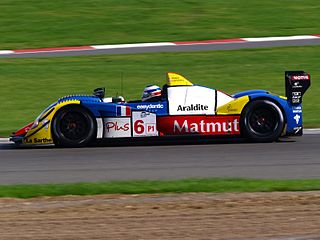
Courage Compétition was a racing team and chassis constructor company now owned by Oreca, based in Le Mans, France near the Circuit de la Sarthe. It was founded by Yves Courage, a French race driver who ran hillclimbs before founding the company. Following the purchase of Courage by Oreca in 2007, Yves Courage has refounded the company as Courage Technology in 2010, attempting to develop electric racing cars.

The McLaren F1 GTR is a racing variant of the McLaren F1 sports car first produced in 1995 for grand touring style racing, such as the BPR Global GT Series, FIA GT Championship, JGTC, and British GT Championship. It was powered by the naturally aspirated BMW S70/2 V12 engine. It is most famous for its overall victory at the 1995 24 Hours of Le Mans where it won against faster purpose-built prototypes in very wet conditions. The F1 GTR raced internationally until 2005 when the final race chassis was retired.

The 2001 European Le Mans Series season was the only season for the IMSA European Le Mans Series. It is a series for Le Mans Prototypes (LMP) and Grand Touring (GT) race cars divided into 4 classes: LMP900, LMP675, GTS, and GT. It began 17 March 2001 and ended 6 October 2001 after 7 races.

The Panoz Esperante GTR-1 was a race car developed by Panoz Auto Development and Reynard Motorsport for grand tourer endurance racing in 1997. Although named after the Panoz Esperante roadster, the GTR-1 actually bore no mechanical relation to the production Esperante, instead sharing only minor styling points. Only two road-legal GTR-1s were built to meet homologation requirements set forth by the ruling bodies which the racing cars ran under.

Élan Motorsport Technologies is an American enterprise that serves as an umbrella company containing the race car engineering, development and manufacturing companies owned by American racing and automotive company conglomerate Panoz Motor Sports Group. Élan engineers, designs and builds Panoz-branded race cars and components, since its founding it has also acquired several manufacturers, including famous Formula Ford builders Van Diemen and IndyCar Series constructor G-Force. Élan-built cars have successfully competed in the American Le Mans Series, Le Mans Series, IMSA Prototype Lites and various other championships, racing series and types of professional racing throughout the world. It designs, develops and manufactures full line race cars, i.e. chassis, bodies, components and engines for professional racing competition for a variety of segments and classes.
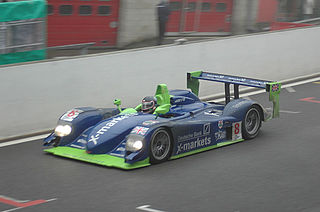
The Dallara SP1, also known as the Chrysler LMP, was a Le Mans Prototype built by Italian firm Dallara. Initially used as part of Chrysler Corporation's attempt to win the 24 Hours of Le Mans, the cars were later sold to customers for use series such as the FIA Sportscar Championship and Le Mans Series.

The Cadillac Northstar LMP was a series of Le Mans Prototypes built by Cadillac for use in the American Le Mans Series as well as an attempt to return Cadillac to the 24 Hours of Le Mans since they first entered in 1950. The Northstar LMPs were named after the Northstar V8 engines which powered them. The Cadillac project ran from 2000 until 2002 when General Motors decided to cancel the project to concentrate solely on their Chevrolet Corvette program. Cadillac returned to prototype racing in 2017 with the Cadillac DPi-V.R in the WeatherTech SportsCar Championship.
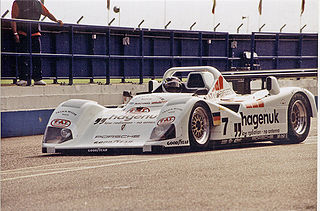
The Porsche WSC-95 was a Le Mans Prototype originally built by Tom Walkinshaw Racing. It was modified by Porsche from the original Group C Jaguar XJR-14 from which it derived, and run by Joest Racing. Originally intended to race in the IMSA World Sportscar Championship, the WSC-95 saw very little race action even though it won the 24 Hours of Le Mans in both 1996 and 1997 without being acknowledged as a factory supported project. It was later upgraded to the Porsche LMP1-98 before being retired. Only two cars were ever built.
The Lola B98/10 was a Le Mans Prototype built by Lola Cars International for use in the International Sports Racing Series, American Le Mans Series, and 24 Hours of Le Mans. It would be the first international sports car built by Lola since they briefly left the sport in 1992 following the Lola T92/10. It would be succeeded in 2000 by the Lola B2K/10.

The Lola B05/40 is a Le Mans Prototype built by Lola Cars International for use in the LMP2 class for the American Le Mans Series, Le Mans Series, and 24 Hours of Le Mans. Developed in 2005, it was intended as a replacement for both the Lola B2K/40 and the MG-Lola EX257. It shares various structural elements with the larger LMP1-class Lola B06/10.

The Panoz LMP-1 Roadster-S was a Le Mans Prototype built for Panoz in 1999. The car was a successor to the Esperante GTR-1 which had competed in the Grand Tourer categories internationally. Following competition in the American Le Mans Series and at the 24 Hours of Le Mans until 2001, the car was replaced by the Panoz LMP07.
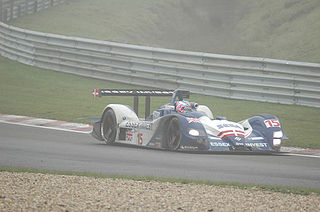
The Reynard 02S was a Le Mans Prototype race car built by Reynard Motorsport in 2002. Intended to replace the failed Reynard 2KQ prototype, the 02S would end up becoming the final new design from Reynard as the company went bankrupt prior to the project's completion.
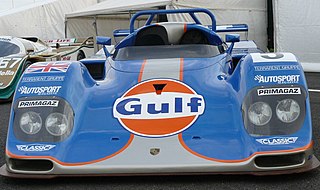
The Kremer K8 Spyder, along with its predecessor, the K7 (1992-1993), were open-cockpit prototypes built by Kremer Racing for use in multiple sportscar series, such as the IMSA GT Championship, Interserie, and International Sports Racing Series. The cars shared many components from the retired Porsche 962 and would eventually go on to win the 24 Hours of Daytona and several championships.

The Riley & Scott Mark III was a sports prototype auto racing car developed by Bob Riley, Bill Riley, and Mark Scott of Riley & Scott Cars Inc.. Initially designed in 1993, the car was created for the World Sports Car (WSC) category which was to debut in the North American IMSA GT Championship during their 1994 season. It was not until 1995 that the first Mk III was completed, but the construction of further cars allowed a variety of teams to campaign in several North American and European racing series, including competing at the 24 Hours of Le Mans.

The CLM P1/01, renamed ENSO CLM P1/01 in 2017, is a sports prototype racing car built for the Austrian and Romanian based team ByKolles Racing. It is designed to meet the 2014 LMP1-L regulations for Le Mans Prototypes in the FIA World Endurance Championship as well as at the 24 Hours of Le Mans. The P1/01 debuted at the 2014 6 Hours of Circuit of the Americas, round four of the FIA World Endurance Championship.
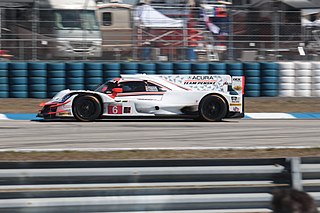
A Daytona Prototype International (DPi) is a type of sports prototype racing car developed specifically for the International Motor Sports Association's WeatherTech SportsCar Championship, as their top class of car, acting as a direct replacement, and spiritual successor of the Daytona Prototypes. They are named after the main series event, the Rolex 24 at Daytona. The class made its racing debut at the 2017 24 Hours of Daytona.


















